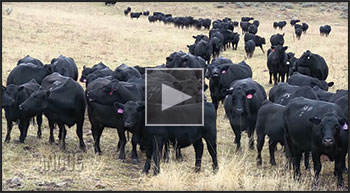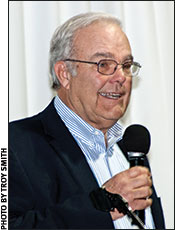Managing Risk
Risk management includes any technique applied for assessing, minimizing or preventing business losses.
It has been said, “Life happens,” and veteran ranch manager Wayne Fahsholtz would add, “risk is a part of life.” Formerly president of Padlock Ranches and now a principal in the Wyoming-based AgWin Group Consulting firm, Fahsholtz spoke during the 24th Range Beef Cow Symposium in November. He told the audience composed mostly of cow-calf producers that, contrary to what some people believe, managing risk in small-scale and medium-sized operations is not that different from risk management for large operations.

Watch an interview with Wayne Fahsholtz on The Angus Report at http://bit.ly/1OpnvJx.
While many cattle folk equate risk management with price protection, Fahsholtz said risk management is any technique applied for assessing, minimizing or preventing business losses. Some of the greatest losses to ranch businesses can come as a result of weather events. Drought, Fahsholtz said, is an event that periodically visits nearly every cattle operation.
“Drought presents a huge risk, but it is lessened when you always take good care of your grazing resources,” Fahsholtz stated, explaining that grazing management that allows each pasture adequate rest will help mitigate drought risk. “When you manage for healthy soils and plants and capture the precipitation you do receive, the ranch is less impacted by drought, or it is impacted more slowly, and it recovers faster afterward.”

According to Wayne Fahsholtz, if subpar moisture has been received, the ranch manager must consider destocking the ranch.
Fahsholtz recommended a drought plan that includes “critical dates” for adjusting grazing management, particularly stocking rates, during years of drought. He used northern Wyoming, where 70% of annual precipitation is received between March and June, as an example. Precipitation received by mid-May is an important indicator of whether a ranch can maintain its “usual” carrying capacity during the grazing season. Therefore, May 15 is a critical date.
According to Fahsholtz, if subpar moisture has been received, the ranch manager must consider destocking the ranch. He recommends starting with removal of part of or all of the stocker cattle on grass. Reduction of the number of replacement heifers saved might come next. If it’s still too dry in June, it’s likely time to sell some cull cows. Grazing pressure could be further reduced in August or September by early-weaning calves. If drought persists longer, bred cows could be marketed in September or October.
Of course, the ability to destock by class of cattle is only possible if the ranch maintains a mix of enterprises. Managing stockers in addition to a cow-calf herd, therefore, lends itself to risk management.
“A safe stocking-rate limit needs to be established for the main ‘keeper’ herd,” Fahsholtz explained. “The other classes of cattle provide a way to destock quickly if the need arises.”
Fahsholtz said many ranch operations fail to plan for management succession, and that can put those businesses at risk, either in the short or long term. He recommended planning for succession of leadership in the event the current manager or other key leaders are unable to continue.
According to Fahsholtz, every ranching operation needs a marketing plan, and some consideration should be given to managing market risk. Video sales can increase exposure to a wide range of buyers, and sellers can market cattle well in advance of delivery, instead of marketing during the normal “fall run” when prices often are lower. Sharing from his own experience, Fahsholtz said marketing alliances represent one way of reducing risk of market price volatility.
“Country Natural Beef, for example, offers a set price that all of the members of the cooperative agree on each year,” Fahsholtz said. “Some alliances offer producers a window of opportunity to sell or place cattle with a price formula plus incentive. Other programs offer a basis contract, which allows a producer an opportunity to price cattle months in advance, and the buyer takes a position on the futures board.”
Reputation and relationships matter when marketing cattle, Fahsholtz stressed. A ranch’s reputation, relative to the kind and quality of cattle produced and how they are produced, really matters. Additionally, relationships with lenders, suppliers, customers and neighbors also affect a rancher’s risk.
Fahsholtz urged ranchers to consider forming an advisory board consisting of nonpaid members from among the people necessary to the ranch’s long-term survival. Likely candidates include bankers, major suppliers, accountants and representatives of government agencies — people with whom the ranch must interact on a regular basis. Fahsholtz also suggested including off-farm family members.
The board might need to meet only once per year, mainly to lend focus to long-term business planning. Fahsholtz said a rancher can benefit from sharing his or her vision and receiving feedback from an advisory board. Of particular benefit is the opportunity to strengthen relationships with people who are important to the ranch’s success.

Editor’s Note: This summary is part of the Angus Journal’s online coverage of the 2015 Range Beef Cow Symposium, which was hosted Nov. 17-19, 2015, in Loveland, Colo. For additional coverage or to listen to this presentation, visit the Newsroom at www.rangebeefcow.com. The Angus Journal’s coverage of the event is made possible through collaboration with the event committee and sponsorship of LiveAuctions.tv.






